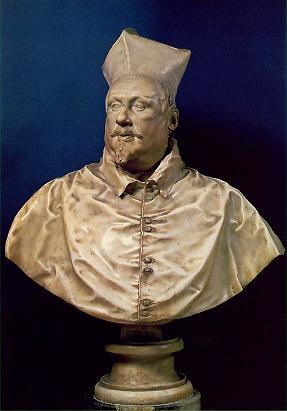|
|
 |
|
Bernini's Sculptures in the Villa Borghese |
|
written
by nmdaybaz / 09.22.2005 |
|
|
| |
Patron |
| |
| |

|
| http://www.artchive.com/artchive/b/bernini/borghese.jpg |
| Portrait Bust of Scipione Borghese |
| Bernini (c. 1932) |
| |
|
The broad goals Scipione Borghese intended to achieve through Bernini’s work in his villa have been previously discussed. The subject matter of each statue, however, had its own agenda that supported the patron. The magnificence of each work housed in the Cardinal’s impressive villa was not all that helped support the positive image that he hoped to project; each of Bernini’s sculptures, in fact, served Scipione Borghese in their own unique way.
The first major work, Aeneas, Anchises and Ascanius Fleeing Troy, done by Bernini is a scene from the legendary founding of Rome. This in itself seems to show the love the Cardinal had for his city, but there was another personal side to it. According to Boucher, the image of the man, Aeneas, carrying his aging father was “representing, by use of allegory, Cardinal Borghese’s piety and support for his uncle in the affairs of state.” In Rome during this time period, the pope was an extremely powerful figure, and it was very beneficial for any citizen to show the strength of their allegiance. Even as Pope Paul V’s nephew, Scipione Borghese was not exempt from the need to use this strategy.
Since Apollo and Daphne was commissioned in place of Pluto and Persephone, both sculptures share similar purposes. After Pope Paul V died, the pope who succeeded his uncle was not in great favor with Scipione Borghese, and it seems this feeling was mutual. The Cardinal, however, was a political man, and his power had previously come from the pope. With the loss of his title as Cardinal Nephew, he lost his important role in the papal court. To regain Pope Gregory XV’s good graces, he gave his nephew the recently completed Pluto and Persephone as a sort of peace offering. The replacement commissioned was similar: both consisted of a male in pursuit of a female. This time, however, instead of a triumphant god with his catch, Apollo lost his prize as she was transformed into a tree. The similarity can be noted between Scipione Borghese’s loss of power as Cardinal Nephew and the transformation of his role in the papal court.
The final statue, David, contains a bit more subtle connection to Scipione Borghese. The Borghese family symbol is an eagle and a dragon, both to be found in various forms throughout the villa. At David’s feet, the harp that he was to play after his victory is decorated with an eagle’s head, a direct reference to the Borghese family. This connects the Borghese family to a symbol of victory, a connection by which Scipione Borghese would have been flattered. Additionally, the biblical story of David and Goliath tells the tale of a small force defeating a larger one. It is a story that the Borghese family would be proud to portray as the church triumphing over pagans.
|
| |
|
| |
|
|
 |
|

